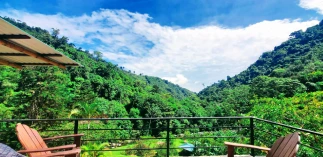Here at our Costa Rican mountain retreat, nature’s wonders surround you. From the vibrant blossoms bursting with color to the symphony of birdsong that fills the air, every day is an exciting exploration of the country’s rich biodiversity. Today, we turn our focus to a fascinating resident of the rainforest understory, the White-tipped Sicklebill.
A Bird with a Built-in Straw
As its name suggests, the White-tipped Sicklebill is a hummingbird unlike any other. Its most striking feature is the uniquely decurved bill, shaped remarkably like a raptor’s claw. This specialized beak isn’t just for show – it’s a crucial tool for the bird’s survival. The White-tipped Sicklebill acts as a pollinator for Heliconia plants, whose tubular flowers curve in a similar way. The decurved bill allows the hummingbird to reach deep within the flower’s chamber, sipping nectar inaccessible to other birds with shorter, straighter beaks. It’s a perfect example of co-evolution, where both the bird and the plant benefit from this specialized adaptation.
Finding a Flash of White in the Green Embrace
These feathered jewels are most often seen flitting about the dark rainforest understory. Their streaky green plumage provides excellent camouflage amidst the dense foliage. But keep an eye out for a flash of white – the telltale sign that identifies this particular sicklebill. Unlike its close relative, the Buff-tailed Sicklebill, the White-tipped boasts only white tips on its tail feathers, making it a true avian marvel to behold.
A Glimpse into the Private Life of a Sicklebill
While spotting a White-tipped Sicklebill can be a challenge due to their swift movements and preference for the forest’s hidden depths, their presence is often revealed by their melodious song. Polygynous by nature, males gather in small groups called leks, singing and performing aerial displays to attract females. The lucky chosen females then take charge of building tiny cup-shaped nests hidden amongst Heliconia leaves, where they raise the next generation of these extraordinary birds.
Where to See the White-tipped Sicklebill
Since White-tipped Sicklebills favor the rainforest understory and tend to avoid feeders, spotting them requires venturing into their natural habitat. Here at our mountain retreat, nestled deep within the Costa Rican rainforest, you have a great chance of encountering these elusive beauties. Our experienced guides can help you navigate the forest trails and point out the subtle signs that might reveal the presence of a White-tipped Sicklebill.
So, keep your eyes peeled and your ears tuned as you explore the rainforest with us. With a bit of patience and guidance, you might just be lucky enough to catch a glimpse of this magnificent bird with the built-in straw, the White-tipped Sicklebill.
For more information, please view our comprehensive guide about the birds of Costa Rica







